Backyard walkways enhance both the beauty and function of your yard, connecting different areas and creating paths for relaxation outdoors.
Whether you prefer natural flagstone winding through gardens or modern concrete pavers leading to a patio, we’ve gathered diverse walkway ideas using various materials and styles to inspire you
Incorporate Stepping Stones
:max_bytes(150000):strip_icc():format(webp)/front-porch-landscape-ideas-read-ckendree-0822-2000-214079451fad4230af5598a468fc26b7.jpg)
Massive stepping stones in ascending heights create the look of a natural walkway while accommodating a change in elevation.
Tidy edging and a low stone wall define the borders.
Keep It Simple
:max_bytes(150000):strip_icc():format(webp)/the-best-front-lawn-landscaping-ideas-lead-1222-2000-82f16dc75672459e9da840fdc5edac03.jpg)
A gently winding walkway cuts across a tidy lawn, wrapping around a showpiece tree in front of this one-story home.
Neutral pavers and a traditional offset layout are a timeless, polished option.
Line With Bright Blooms
:max_bytes(150000):strip_icc():format(webp)/ms-small-backyard-landscaping-ideas-border-garden-fc07655280eb443794583e278088a8fa.jpg)
A rustic walkway made from close-set pavers and lined with rounded tree boughs gets a splash of color when beds of bright red tulips are in bloom.
Leave Space Between Squares
:max_bytes(150000):strip_icc():format(webp)/pergola-lighting-fa1d0a966263436cb78fd85ecc01bde6.jpg)
Lines of square pavers create a wide pathway leading to—and around—this pergola.
Using grass to fill the space between the squares keeps the walkway linked to the yard, allowing it to connect multiple outdoor spaces without overwhelming the lawn.
Pair Natural Stones with Neat Pavers
:max_bytes(150000):strip_icc():format(webp)/turkey-hill-pool-c1589ed8-0120-0237b785812640b681a6ead756f7ffc8.jpg)
This picturesque pool is surrounded by a walkway of square pavers in varying sizes and colors—but it’s the natural stones and small patches of greenery leading to the pool that accent the abundant florals, creating a peaceful, bucolic space to relax.
Stone Footpath
:strip_icc():format(webp)/102308121-987a941ce1cc4aaf86eb5f24a861bf02.jpg)
A stone footpath leads to a charming playhouse in this magical backyard corner.
When choosing a design, consider where it leads to determine what material and pattern best fit the surroundings.
Create a whimsical look with garden path ideas that use undefined shapes to lead to this delightful retreat.
Brick Pathway
:strip_icc():format(webp)/102244782-a30bf4aacb044a35be785636437d4b66.jpg)
A winding brick pathway offers different views of the backyard, creating little nooks and pockets of outdoor space to explore as you stroll around.
The footpath curves around stone retaining walls that add height and dimension and highlight blossoming trees.
Defined Design
:strip_icc():format(webp)/102628713-8a1af7e0b3a844389ee48d7f58a1039a.jpg)
A flagstone path gives you plenty of options because you can change the look based on how closely you arrange the stones.
The more spread out they are, the fewer you need, which cuts down on cost.
If the stone path leads through grass, it allows for growth between the stones, which can completely change the backyard pathway idea.
Lastly, the spacing can determine the design style since a more spread-out, organic path looks romantic and casual, whereas tightly arranged stones create a more formal aesthetic.
Backyard Charm
:strip_icc():format(webp)/102653367-89f942e51fd04144b2abdec0bbb32571.jpg)
Large, irregular stones make up a charming path through this fairytale-like trellis surrounded by blooming flowers.
This combination creates an endearing backyard design filled with an air of wistful nostalgia, which would be a good backyard pathway idea for cottage-style homes.
Create a cozy, private retreat by adding a trellis with climbing vines for seclusion and stringing fairy lights or lanterns for a magical nighttime glow.
Simple Square Path
:strip_icc():format(webp)/2018_10_Wood_Mikkelsen_Shot9_187-e0973c5798094b69896b98c6151408bc.jpg)
Precisely laid stones create a walkway that lines the fence and leads to the gate in this small backyard.
The size and shape of the stepping-stones you use give you the flexibility and creative opportunity to create various designs, whether a simple square layout like this or a more elaborate pattern of smaller stones.
The design of this walkway suits the bungalow-style home, with its simple lines and understated profile.
Keep It Organic
:strip_icc():format(webp)/davidtsay210528.BHG.DonaldsonGarden.022-f95730eedb064e5c945325f67a646236.jpg)
Garden path ideas can transform your outdoor space by allowing the free, organic nature of how plants grow.
These stones are interspersed among grass and gravel and spread out in different directions.
Their varying sizes create a mosaic-like effect that fits well with the casual aesthetic of this garden.
Add a Wall
:strip_icc():format(webp)/102802996-010b2d3be2f945b7a0e55f9bb5403e78.jpg)
A low concrete wall lines this square stone pathway, creating height and showcasing flowers and plants at two different levels.
The grid-patterned paving stones, along with the smooth texture of the patio leading into the dining area, contrast the organically blooming garden for visual interest.
A Path to a Favorite Spot
If you have an unused area of your yard that would make a great spot to relax and enjoy some fresh air, consider adding a concrete paver walkway and a concrete patio with outdoor furniture.
This will transform an underutilized spot into a potential favorite area of your home.
Walkway Around the Pool
The concrete squares around this backyard pool add a polished look to the backyard.
The grass acts as spacers between the stones and offers some relief when walking around on a hot summer day.
Space for Container Plants
Even though a walkway is typically used for getting from one part of the yard to the other, you can get creative with it.
These concrete stepping stones are the perfect spot for potted plants.
This design adds a lush look and a laidback feel to the backyard.
A Dirt Pathway
When it comes to designing your backyard, you may want to spend less of your budget on the pathway and more on other features like this stunning wood plank fence.
A pathway doesn’t always have to be complicated; a simple dirt pathway for the fire pit area looks great when paired with the fence and well-manicured lawn.
Grass Concrete Pavers
:max_bytes(150000):strip_icc():format(webp)/mindy-gayer-marigold-project-62-2d0b87a4f0c84d35beaec026c671eb02.jpg) Mindy Gayer Design Co / Photo by Vanessa Lentine
Mindy Gayer Design Co / Photo by Vanessa Lentine
Grass concrete pavers are concrete pavers that allow grass to grow between them for an elegant, streamlined look.
This backyard features a concrete patio with a paver walkway set at a diagonal for a one-of-a-kind look.
Elegant Cobblestone
:max_bytes(150000):strip_icc():format(webp)/GettyImages-1093940244-Sergii-Petruk-316b339564ec481b9909bcce9aeaae10.jpg) Sergii Petruk / Getty Images
Sergii Petruk / Getty Images
If your backyard landscape is perfectly manicured and you love that polished look, you need a walkway to match.
Cobblestone brings a uniform look to any space while adding visual appeal through its variety of colors.
We love the way this walkway seamlessly leads you up into the garden.
Simple Walkway in a Lush Garden
When you have a lush, tranquil garden like this one, you’ll want the walkway to blend right into the surroundings.
This elegant stone walkway is simple so it doesn’t take away from the beautiful plants and row of pergolas.
Concrete Pavers
:max_bytes(150000):strip_icc():format(webp)/gazebo-and-pergola_Lady-Landscape-ba470b00ffce42a5830c9780003eda41.jpg) @ladylandscape / Instagram
@ladylandscape / Instagram
These concrete pavers not only provide a walkway to get from the outdoor kitchen to the dining area, but they also serve as a pool deck and a visually appealing design aesthetic.
A Streamlined Look
:max_bytes(150000):strip_icc():format(webp)/CathieHong_Emory_108-margaretaustinphoto-eabf52cc58e1455b95ab6a443ef635a0.jpg) Design by Cathie Hong / Photo by Margaret Austin Photo
Design by Cathie Hong / Photo by Margaret Austin Photo
This backyard features many clean, sleek lines, from the home exterior to the pergola.
The concrete walkway from the pergola to the house reflects the lines on the house and pergola for a streamlined look.
Set the Walkway Aside
:max_bytes(150000):strip_icc():format(webp)/GettyImages-1357304167-John-Keeble-344612ea1cc2449ebf0e3617e8f2021e.jpg) John Keeble / Getty Images
John Keeble / Getty Images
If your backyard is small, it’s not ideal to have a walkway go through the middle of the yard.
Instead, add a walkway on one side so you can enjoy a larger lawn and garden area on the other side.
A Touch of Color
This narrow backyard features succulents, tropical plants and a stucco exterior.
The red clay walkway brings color while still staying true to the minimalistic vibe of the home.
Embrace Stone
:max_bytes(150000):strip_icc():format(webp)/katemarkerinteriors3stofferphotography-4dc1162f79324a8391949c9d90bc9676.jpg) Design by Kate Marker Interiors / Photo by Stoffer Photography
Design by Kate Marker Interiors / Photo by Stoffer Photography
Stone can be an expensive option for a patio or walkway, but concrete can oftentimes mimic the look of stone.
This walkway features concrete pavers that lead to a concrete patio before leading to the backyard.
The look is as elegant as stone without the higher cost.
Stone Steps Over a Pond
:max_bytes(150000):strip_icc():format(webp)/ladylandscape2instagram-548d038ca61f43d091116a0eb2165b14.jpg) @ladylandscape / Instagram
@ladylandscape / Instagram
This small backyard pond gets an elegant makeover with stone steps that lead over the pond to the backyard pool.
The stone anchors the space among the surrounding lush garden and vines growing on the pergola.
Diamond Pattern Pavers
:max_bytes(150000):strip_icc():format(webp)/katemarkerinteriorsstofferphotography-6f908bc790804aca9fd1333b0542663e.jpg) Design by Kate Marker Interiors / Photo by Stoffer Photography
Design by Kate Marker Interiors / Photo by Stoffer Photography
If you love the clean lines of square concrete pavers but want a little more visual appeal, lay them in a diamond pattern.
The concrete pavers by this backyard pool look elegant and stylish when paired with the stone patio just beyond.
Large and Small Concrete Pavers
The front yard of this Mediterranean-inspired home features two matching concrete paver walkways in different sizes.
The small walkway leads to the front door, while the large concrete pavers lead to the backyard.
This provides a cohesive and functional look.
Modern Monochrome
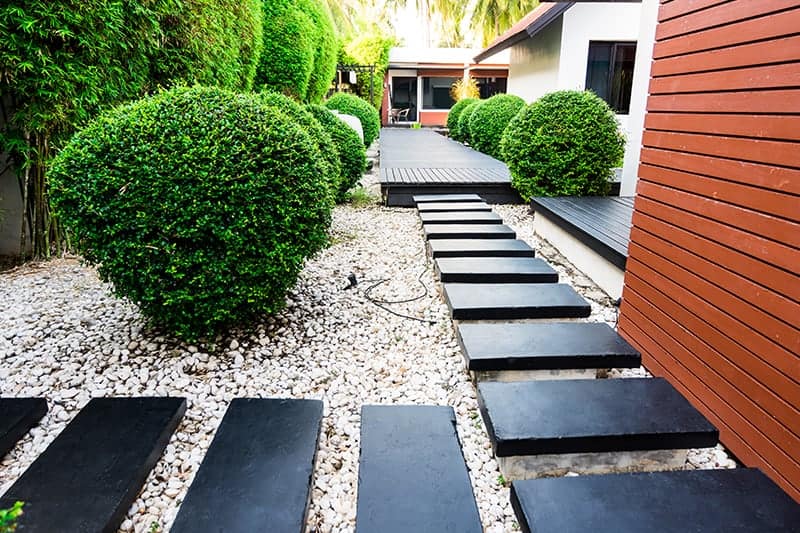
The stepping stones in this image have several features going on, which make a big statement, but you could choose to use this for inspiration and copy just one or two of the elements.
The most impact comes from the monochrome coloring, which makes a stark contrast with the black stones set against the white pebbles.
This is an inexpensive but impressive design, which can be achieved by just painting your paving slabs. Another interesting element of this walkway is the way the stepping stones are raised.
This will encourage people to step from one stone to the other without standing on the pebbles beneath, keeping them from dispersing.
Red Herringbone
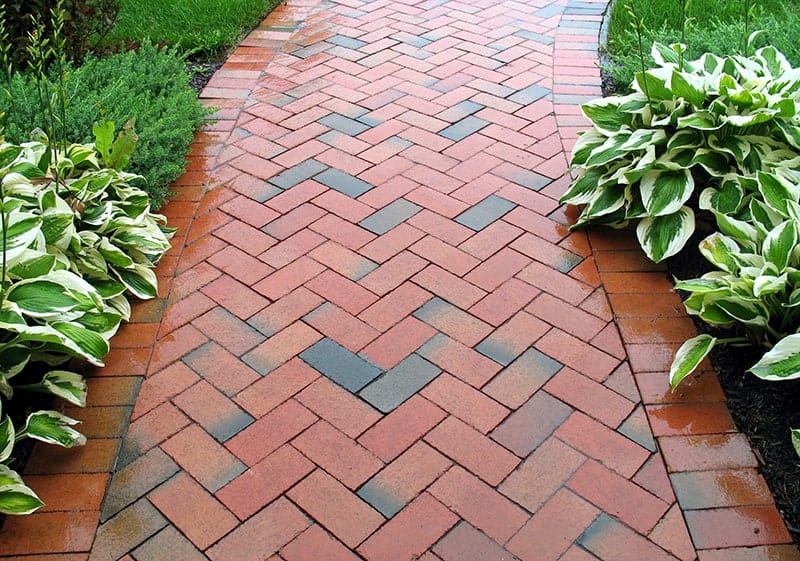
This herringbone pattern has been created with red bricks, making an interesting and sophisticated looking feature out of something very simple.
In order for this pattern to work, it has to be properly measured out and laid with precision, as any bricks which are out of place would ruin the overall look.
The color of the bricks contrasts well against the lawn, so red might be a good option to use if you want your pathway to stand out against plants or grass running along each side.
Circular Steps
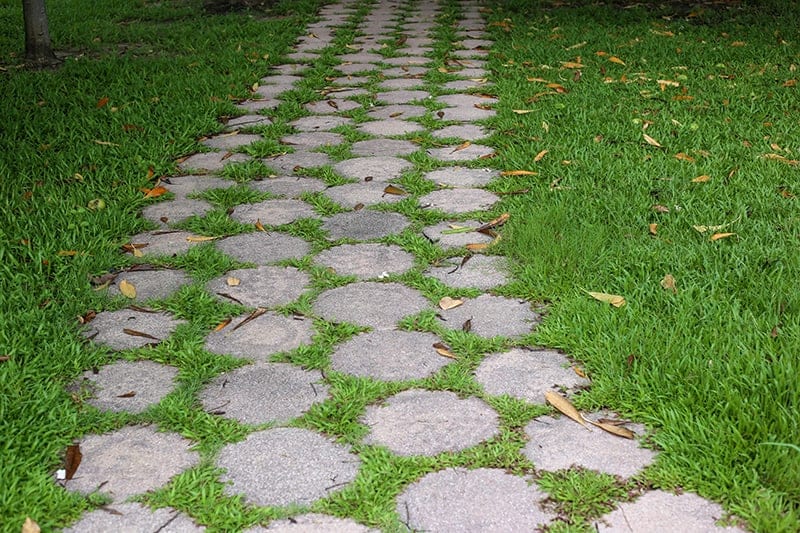
Round paving stones lined up in neat rows gives a pretty and unusual pattern for a walkway.
This is a simple idea which can be achieved very easily on lawn surfaces, by simply digging circles out of the lawn and setting in the stones.
The drawback of this is that maintaining the lawn around the stones can become more difficult, and people may walk on the patches of the lawn itself, which fall in between the stones, and this may wear it back to bare patches of soil.
Neat and Neutral
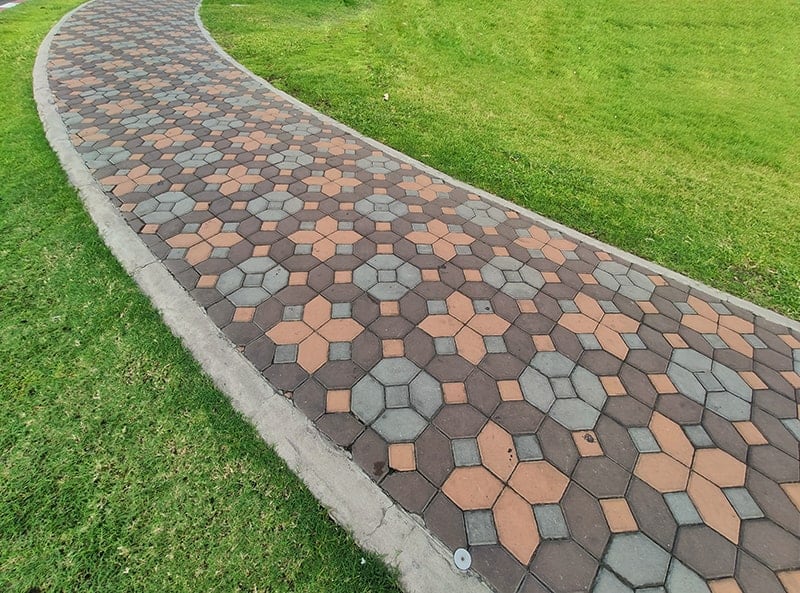
This path creates an interesting characteristic which stands out amongst the background of the grass lawn.
This sort of patterned walkway works well in gardens, which are otherwise quite simple and plain, so that it can be the central feature, to prevent it from becoming too busy.
The bricks used in this walkway are different colors from a neutral palette, which creates a colorful and decorative look while still having a natural and earthy feel.
Patterned walkways such as this give a professional-looking finish to a property, and can greatly improve curb appeal and potentially increase the value of your home.
Painted Planks
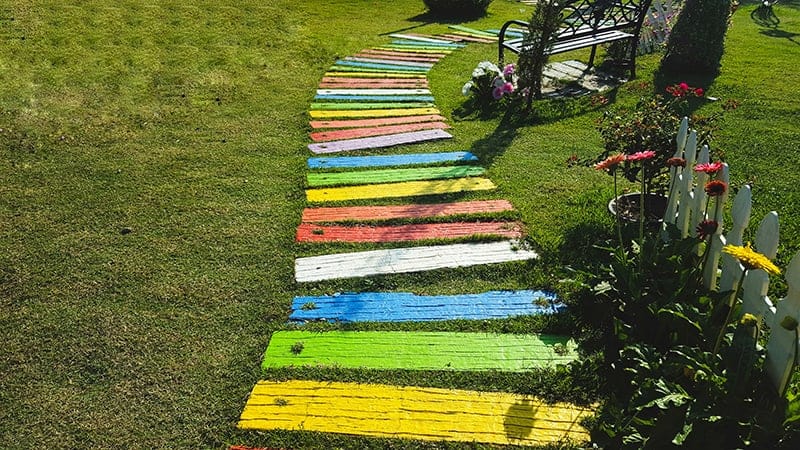
If you want to create a new walkway on a small (or non-existent!) budget, then laying down wooden planks amongst the lawn is a cheap and easy solution.
If you have some pallets lying around, or an old bookcase you can disassemble, then you have got yourself a free DIY walkway.
Dig holes in the lawn the same shape as the wooden planks, and tuck them in.
This walkway has opted for a bright rainbow effect by painting their planks in different striking colors, but you could choose a color theme that matches your garden decor or use any leftover paint you have taking up space in the garage.
Stepping Stone Murals
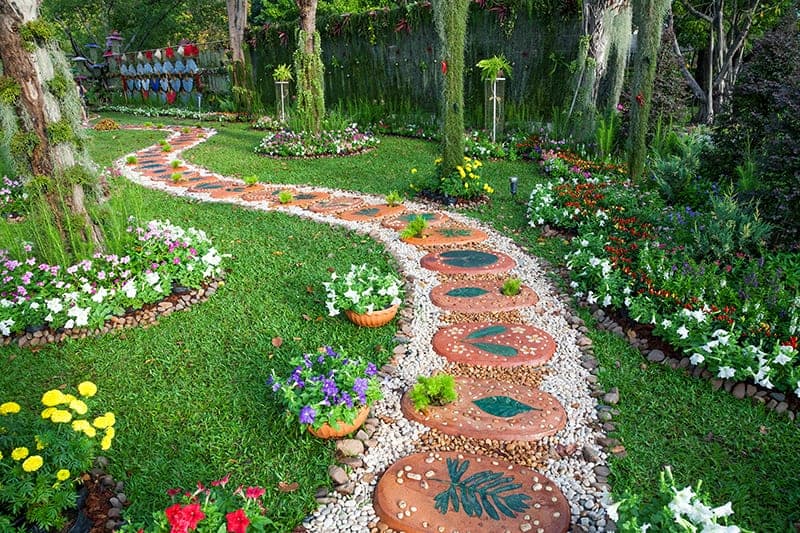
This whimsical walkway is centered around large pebble-like paving stones that have been hand-painted with murals of flowers and foliage.
These give a cute and country cottage feel to the yard, along with an abundance of flowers and smaller pebbles surrounding the stepping stones.
The curved and winding nature of the walkway also adds to the magical feel, making the whole space reminiscent of a fairy tale or an enchanted garden.
This type of walkway would be a great project for artists and anyone with a flair for creativity.
By painting murals on your stepping stones, you can create a truly unique walkway customized to your own interests.


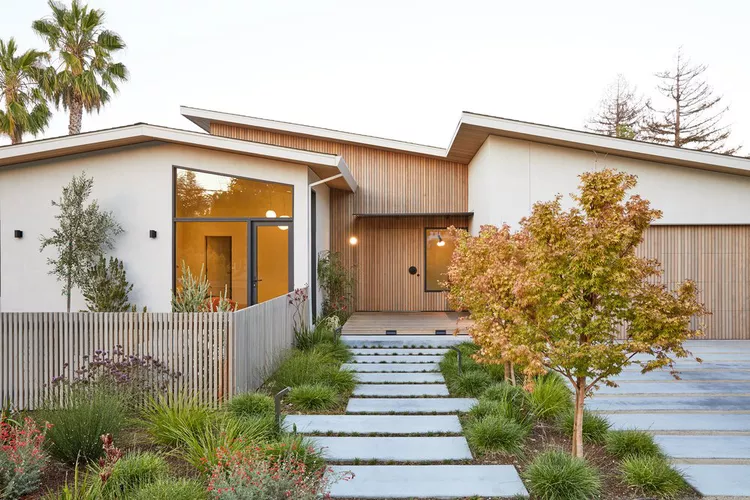
:max_bytes(150000):strip_icc():format(webp)/maite-granda-project-pinecrest-002-b08d2e55932e4b79841ddb704d162427.jpg)
:max_bytes(150000):strip_icc():format(webp)/concrete-steps_pool-deck_LeClair-Decor-e567afaf61044916bd14510d9f42778f.jpg)
:max_bytes(150000):strip_icc():format(webp)/dazeydenpots-e05394b2927d44dfb1fd522419746e4f.jpg)
:max_bytes(150000):strip_icc():format(webp)/dirtpathwayhomeconsultant-47669ad9e91b4a65945f93482929518a.jpg)
:max_bytes(150000):strip_icc():format(webp)/kgdesigns-6008fb56abbd4b55a2e71e38d4141fad.jpg)
:max_bytes(150000):strip_icc():format(webp)/HomeConsultant1-5bf75bf466cf4c538139c81f57ec6eb9.jpg)
:max_bytes(150000):strip_icc():format(webp)/homeconsultant2-7853b63c13d34761b837d7ed7af47b12.jpg)